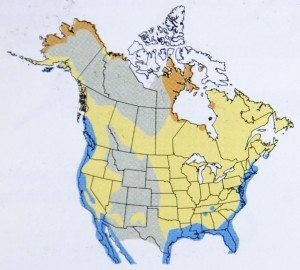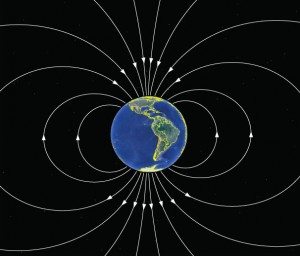The magnetic attraction of birds
By Jack Dumbacher
By now, most of the birds that summer in the Bay Area have settled into their new territories and are well on their way to producing this year’s family of nestlings. The warblers, orioles, tanagers, and vireos are singing and defending their territories – often the same territories where they nested last year or will nest next year. Likewise, many of our winter migrants are long gone, and probably already settled in their summer homes.
These long-distance migratory movements have long fascinated ornithologists, with the primary question: How do the birds find their way?
Decades of research have shown that birds use a variety of information including visual landmarks such as coastlines, rivers, stars and sun-angle. Even odors have been shown to be important for homing pigeons. But one of the most peculiar and interesting of all migratory aids is magnetic orientation.
Birds appear to have a magnetic sense.

Avian magnetic sense was first demonstrated in the 1960s by Friedrich Merkel, Wolfgang Wiltschko and colleagues in Germany using caged birds in altered magnetic fields. Birds adjusted their orientation when the magnetic field was altered. This was a stunning and unexpected result – so much so that many other researchers sought to test the effect using magnets strapped to the backs of birds, and even created bird backpacks that induced magnetic fields using coils of wire with electrical currents (called Helmholtz coils).
More and more researchers showed that birds respond to magnetic fields, often in predictable and useful ways. It’s now clear that birds can use this sense to orient to the earth’s magnetic field during migration.
The earth’s magnetic field contains a great amount of geographic information. For example, the direction of the field lines identifies the north-south azimuth, and the polarity of the magnetic field lines identifies which direction is north and which is south. The inclination (whether the field is level, pointed down, or up) can provide information about latitude. The strength of the magnetic field also provides information about latitude, as the field is stronger near the poles than at the equator. Local variations in the field could even be used as local magnetic “landmarks” for navigation.
But these are weak and subtle forces – can birds really use all of this information?

A recent research article in Science magazine by Le-Qing Wu and J. David Dickman [1] argues yes, they do. Wu and Dickman used techniques for tracking bird brain activity. By monitoring brain stem neurons in the presence of magnetic fields, they showed that birds can encode the inclination, intensity and polarity of magnetic fields. Furthermore, they showed that birds’ magnetic sense is optimized for detecting fields having the same (relatively weak) strength as the Earth’s magnetic field. And they were even able to show which parts of the brain are involved in “decoding” the information.
Wu and Dickman’s work offers hope for answering an additional question — which avian organ detects the earth’s magnetic field.
By looking at the brain regions involved in magnetic sense, they can potentially track the neurons to the signal source, and know where to look for the magnetic sense organ. Although their work is not yet conclusive, it appears likely that these brain regions are receiving signals from the inner ear. They cannot yet rule out the possibility of signals from the beak or retina of the eye, but this still narrows down the places to look.
So the next time you see birds migrating through pea-soup-thick San Francisco fog, consider that they are probably using their magnetic sense to maintain their direction.
And just how birds can do this remains one of the great mysteries.
———————————
[1] Wu, L.Q. and J.D. Dickman, Neural Correlates of a Magnetic Sense. Science, 2012. 336(6084): p. 1054-1057.
———————————
Jack Dumbacher, a board member of Golden Gate Bird Alliance, is Chair of the Department of Ornithology and Mammalogy at California Academy of Sciences.
